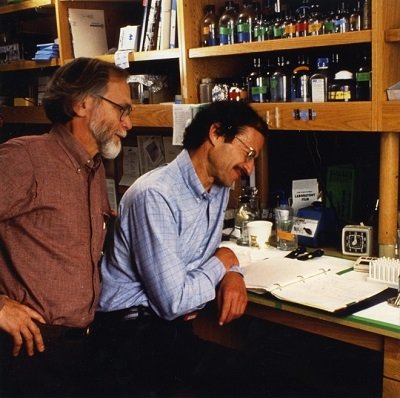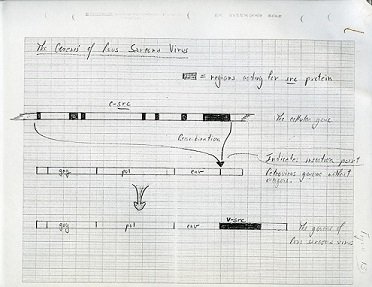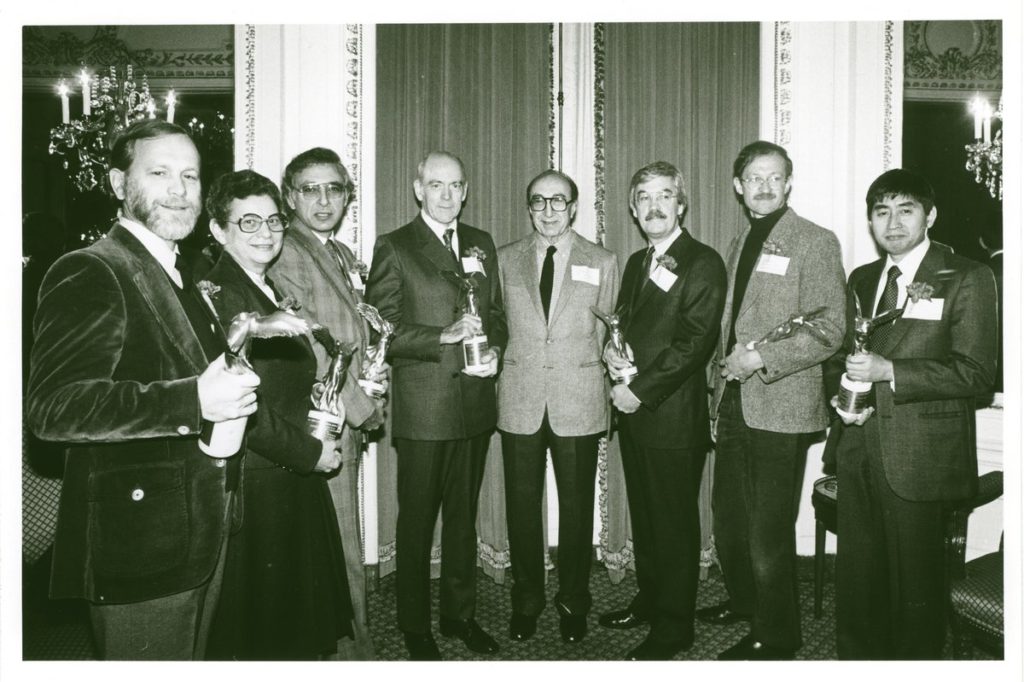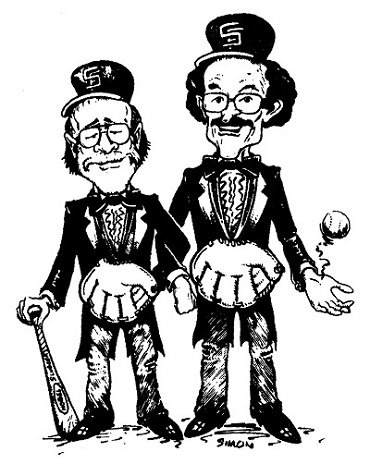Tales of scientific breakthrough often focus on individual researchers — think Albert Einstein or Isaac Newton — toiling away over their notebooks or pieces of lab equipment. But even before the advent of ambitious Big Science endeavors such as the Human Genome Project in the 1990s, a few teams of scientists rose to the prominence of the legendary ‘lone geniuses’. Among those are J. Michael Bishop and Harold Varmus, who together were the first to discover a cellular gene involved in cancer.
“In most places, the stress is on independence, and we [thought] that we were more than the sum of our parts and that having [our] group was terrific,”
says Varmus, now a professor at Weill Cornell Medicine in New York City.

J. Michael Bishop (left) and Harold Varmus (right) in the lab (Courtesy of the UCSF Archives & Special Collections)
From the moment that Bishop and Varmus first met, when Varmus stopped by the department that Bishop had just joined at University of California, San Francisco (UCSF), to inquire about a postdoctoral position, “we clicked; it was just that simple,” recalls Bishop, currently professor emeritus at UCSF. Thus began a melding of the minds that lasted more than two decades and, as Bishop wrote, “changed my life and career.” Although Varmus started as a postdoctoral fellow within Bishop’s team, Bishop insists that his title was not apt because Varmus quickly began supervising other members of the rapidly growing group right alongside Bishop. Indeed, within about a year, Varmus was appointed to a faculty position at UCSF. But even as they led their own labs, the two scientists and friends continued their joint research, an unusual arrangement that Varmus has credited to the supportive dynamic in the department fostered by Leon Levintow, who at the time was a senior UCSF faculty member.
Studying RSV to Understand Cancer Genes
The discovery that made the Bishop-Varmus duo famous came several years into their partnership. The pair had decided to branch out from their studies of how Rous sarcoma virus (RSV), a retrovirus that infects chickens, replicates to explore how the virus causes cancer in these animals. At the time, “there was a large accumulation of hints that genetic malfunction might be involved in cancer, but there was really no solid evidence,” Bishop says. Sequencing technology was not yet powerful enough to scour the large genomes of cancer cells for culprit genes, but it was easy to study the small genomes of cancer-causing viruses such as RSV in search of genetic culprits of cancer. “These viruses had handed these genes to us on a platter,” explains Bishop.

A schematic diagram drawn by Varmus and Bishop shows that the normal src oncogene (c-src) is taken up and integrated into viral DNA to form viral src (v-src). (Courtesy of the UCSF Archives & Special Collections)
Other research teams had recently figured out the gene in RSV responsible for its cancerous potency, which was dubbed src, but nobody knew where src came from. The Bishop-Varmus team was poised to answer that question because of their experience making probes that could recognize genes with similar sequences to a given gene of interest (in this case src). Using this approach, they found a version of RSV src in the genomes of birds and mammals, including humans. The finding provided them the foundation to show that src was an important cellular gene — they termed it a proto-oncogene — that could morph into a cancerous gene through mutations caused by insults to the cell. In addition, as presumably happened for RSV and certain other tumor retroviruses, the virus could pick up a copy of the gene as it replicates.
For their game-changing contribution to understanding the genetic origins of cancer, Bishop and Varmus were awarded the 1982 Albert Lasker Basic Medical Research Award, along with Raymond Erikson, Robert Gallo and Hidesaburo Hanafusa. (Hanafusa was one of the researchers who attributed RSV’s cancerous activity to its src gene.) The Bishop-Varmus pair went on to win the Nobel Prize in Physiology or Medicine in 1989 for their work. By then, Bishop says, nearly 30 more cellular proto-oncogenes had been uncovered by studying cancer-causing retroviruses like RSV. One of the genes that Bishop and Varmus helped find shortly after src, called myc, is among the most commonly mutated cellular genes in a wide range of human cancer types.

Recipients of the 1982 Lasker Award with Michael E. DeBakey, Chairman of the Awards Jury
Left to right: J. Michael Bishop, Elizabeth Neufeld, Robert C. Gallo, Roscoe O. Brady, Michael DeBakey, Raymond L. Erikson, Harold E. Varmus, and Hidesaburo Hanafusa
Choosing Careers in Science
One of the most remarkable things about the story of Bishop and Varmus is how close the two men were to not being scientists at all. As a student, Varmus found science to be predictable, not at all adventurous or inspiring. Meanwhile, Bishop was not so much averse to science as unaware of it; although he speaks fondly of the education he got at the two-room elementary school and small high school he attended growing up in rural Pennsylvania, science was not part of the curriculum. Instead, the college experiences of Bishop and Varmus (Bishop at Gettysburg, Varmus at Amherst) sparked in them a deep and enduring love of literature and philosophy. Nevertheless, both of the scientists-in-the-making took the minimum number of science courses to leave the door open to go to medical school. Bishop still had an interest in medicine, but more the teaching than practicing of it, which he traces back to talks he had as a high school student with the physician who cared for his family. Varmus stayed the pre-med course more out of a sense of duty to his father, a family doctor in Long Island, where Varmus was raised.
Both Bishop and Varmus clearly recall the moments that awakened their love of science. As Bishop was drudging through his first two years at Harvard Medical School, he “became aware of the fact that I was more intrigued by discovery than by the prospect of utilizing known knowledge… which is what most physicians do,” he recounts. Fortunately, two of his pathology teachers noticed his apathy and ‘rescued’ him by giving him his first opportunity in a research lab. While few experiments worked for Bishop in those early days, he was exhilarated about the experience and took every chance he could to get back to the lab and strategize on how he could break into the budding field of molecular biology. Bishop has said he was “shrewd” to make his entrée in the area of animal viruses because there was already too much competition in the field of bacterial viruses.

Caricatures of Bishop and Varmus after Bishop asked for a press conference announcing his Nobel Prize to be moved because he had tickets to see the Giants play the Cubs to determine who was going to the World Series
Note: Bishop’s team, the Giants, won that qualifying game. (Courtesy of Jamie Simon, Salk Institute)
Eventually, after finishing his medical school training, Bishop headed to the National Institutes of Health (NIH) to do a postdoctoral fellowship in the Research Associate Training Program, which was created to teach physicians how to do basic science research. “Without the Program, it is unlikely that I could have found my way into the community of science,” Bishop says.
Unlike Bishop, Varmus actually loved medical school, at Columbia’s College of Physicians and Surgeons, once he finally decided to go. In fact, Varmus has said he would probably be practicing clinical medicine today had it not been for the Vietnam War. Because he was “fervently opposed” to the war, Varmus sought out a competitive spot as a research associate at the NIH for two years as an alternative to army service. Varmus was accepted despite his lack of research experience — he suspects his acceptance was actually thanks to the poet wife of his future advisor at the NIH, who wanted her husband to bring some like literary minds into their circle. Varmus joined a cadre of young physicians taking night courses at the NIH to learn how to do science. To Varmus, the overall impact of the Research Associate Program cannot be overstated: “Many people who were in [this] program… ended up being in important positions in a variety of schools and institutions around the country.” And for Varmus personally, he came around to science early on in his project when he figured out a method to measure gene activity in bacteria and felt the thrill of being able to say something new about the world. “Once you have an assay, life is changed.”
By the time Varmus’s tenure was up at the NIH, he knew he wanted to continue research, but research that seemed to have more immediate medical applications than bacterial genetics. Varmus was drawn to cancer research in part because his mother had recently been diagnosed with breast cancer (and within two years of her diagnosis died of the disease). The thinking in those days was that the entire puzzle of cancer could be solved by understanding viruses that cause cancer. (In 1968, the National Cancer Institute (NCI) launched the Special Virus Cancer Program to find viruses that are cancerous in humans like RSV is in chickens, but the effort fizzled within about a year when researchers decided that viruses were probably not a major cause of cancer in people.)
The rub for Varmus was that most cancer research at the time was centered on epidemiology, such as linking cancer cases to environmental causes, or studying therapies such as chemotherapeutic drugs and radiation, and not the thrilling molecular biology techniques on which Varmus had cut his scientific teeth.
Enter Bishop and his group at UCSF. As Varmus was trekking through California in search of a lab to join, he met with a leading tumor biologist at a different university; he eschewed molecular biology but pointed Varmus in the direction of the group Bishop worked with. Varmus wasted no time heading straight to the UCSF campus and distinctly remembers waiting for Bishop and his colleagues to finish their lunch in the exotic-sounding ‘Golden Gate Room’ so he could introduce himself. “We chatted and realized in a very short period of time that we spoke the same kind of language and were interested in the same kind of reductionist biology, and I decided to put my backpack on and come to California,” Varmus says.

Bishop and Varmus in Saunders Court, University of California, San Francisco in 1990 (Courtesy of the UCSF Archives & Special Collections)
Because of their early careers as clinicians and time spent as literati in college (Varmus actually went to graduate school for English before medical school), both men came to science late in their game, at about age 30. These days it is not unusual for high school students to work in labs with an intensity that Bishop and Varmus did not have until twice that age, but Varmus insists that “prolonged adolescence is a good thing.”
“I’d like to believe that people can move from one field to another, especially as multidisciplinary work has become increasingly important,” he said.
For Bishop, one of the benefits of prolonged adolescence was that he could bring perspective from his past life as a medical doctor and integrate clinical stories into the lectures he gave graduate students. As Bishop has said, “I am as devoted to teaching as to research: I find the two vocations equally gratifying.” The additional years Bishop took to make his way to science may also have given him the maturity and confidence to believe in himself, which is his main advice for early career scientists. He added:
“My major failures were when I lost faith in my ideas and surrendered to someone else’s skepticism.”
Colleagues and Friends
Of all the places skepticism can come from in science, Bishop and Varmus were almost certainly not a source of debilitating skepticism for each other. When asked the secrets to their successful scientific partnership, which lasted until 1993 when Varmus left UCSF to become the director of the NIH, Bishop and Varmus offer up a long list of reasons. The two, who remain good friends, enjoyed each other’s company and shared many research objectives, as well as interest in literature and other nonscientific endeavors. But perhaps most of all, as Varmus told the Lasker Foundation, “it worked because I think we both had respect for the other person’s intellect.”
By Carina Storrs
